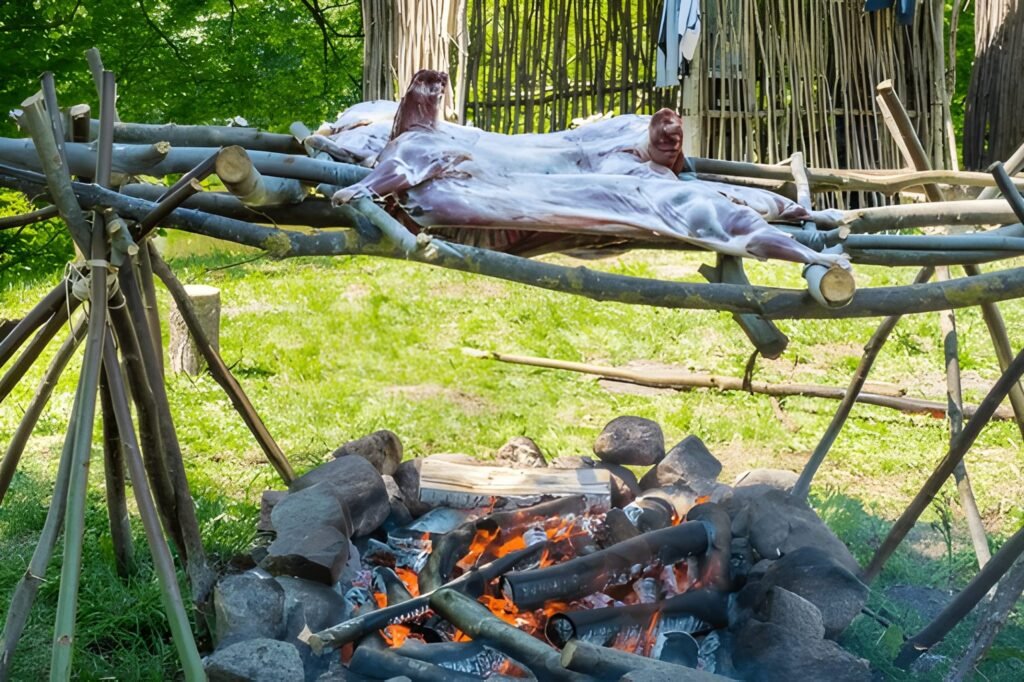The Fire Below the Earth
Picture this: a group of villagers gathers at dawn, digging a shallow pit into the earth. Stones are heated with fire, green leaves laid down, and cuts of meat placed carefully inside. Smoke and steam fill the air as the pit is sealed with soil. Hours later, when the earth is uncovered, the aroma of tender, smoky meat drifts upward. This isn’t just a meal, it’s a tradition that connects generations.
That’s the story of ancient meat smoking methods, especially pit smoking, one of humanity’s oldest ways of preserving and flavoring food. Long before stainless steel smokers or modern barbecue grills, people around the world relied on pits, fire, and patience to transform raw meat into nourishment that could last for days or even weeks.
Why Ancient Meat Smoking Methods Mattered
Smoking wasn’t just about flavor. It was survival. Meat spoils quickly, especially in warm climates. By smoking in pits, communities could:
-
Extend the shelf life of food.
-
Add protective layers of flavor from natural wood smoke.
-
Feed large gatherings during festivals or ceremonies.
-
Create portable rations for travel, hunting, or warfare.
For ancient cultures, pit smoking was a blend of necessity, ingenuity, and ritual. It taught people patience, resourcefulness, and the ability to turn nature’s elements—earth, fire, air, and wood—into tools of survival.
Step-by-Step: How Pit Smoking Works
1. Digging the Pit
The process began by digging a hole in the ground, sometimes shallow, sometimes several feet deep depending on the meat and purpose.
2. Heating the Stones
Rocks or stones were placed inside and heated with fire until they glowed red. These stones provided steady, radiant heat.
3. Layering the Pit
Once the fire died down, green leaves, grasses, or even seaweed were spread over the stones. This created steam and prevented burning.
4. Placing the Meat
Cuts of pork, fish, venison, or poultry were laid inside. Sometimes they were wrapped in leaves or covered with clay for added protection.
5. Sealing with Earth
The pit was covered with more leaves and then sealed with soil, trapping smoke and heat inside for hours—or even days.
6. The Slow Unveiling
When the pit was reopened, the meat emerged infused with earthy, smoky flavors, tender from the steam, and preserved by the smoke.
Table: Ancient Meat Smoking Methods Around the World
| Culture / Region | Traditional Pit Smoking Example | Purpose & Outcome | Legacy Today |
|---|---|---|---|
| Native Hawaiians | Imu – underground oven with stones, leaves, and meat | Ceremonial feasts, community gatherings | Hawaiian luaus still use this method |
| Vikings & Norse | Earth pits with smoked fish or lamb | Preserved food for voyages | Influenced Nordic smoked fish traditions |
| Indigenous North America | Smoking venison and fish over pit fires | Long-lasting travel food (pemmican, jerky) | Still seen in Native smoking practices |
| Polynesian Islands | Pit ovens lined with banana leaves | Combined steaming and smoking | Modern island feasts echo this style |
| Ancient China | Pit smoking with aromatic woods | Preserved pork and duck | Inspired by regional smoked delicacies |
Stories from History
-
Vikings smoked meat in earthen pits to prepare for long sea journeys, ensuring warriors had sustenance at sea.
-
Hawaiians perfected the imu, a communal cooking pit, making feasts as much about bonding as about food.
-
Indigenous peoples of the Americas smoked venison and buffalo in pits, later transforming these techniques into jerky-like foods.
-
Archaeological evidence from Europe and Asia shows charred pits and bones, proving pit smoking existed thousands of years ago.
Smithsonian and National Geographic reports highlight that smoking, along with salting and drying, was one of the three pillars of ancient preservation. Without it, communities wouldn’t have survived winters or long expeditions.
My Own Experience with Pit Smoking
I once joined a cultural festival where food was cooked in a recreated earth oven. The process was long—nearly an entire day of heating, layering, and waiting, but the results were unforgettable. The meat came out tender, smoky, and deeply flavorful, unlike anything from a modern grill.
In my hometown, people still preserve fish by smoking it in homemade pits. The aroma lingers in the air, and even though refrigerators exist, this method continues because it’s tied to memory, culture, and taste.
Tools and Techniques That Made It Work
-
Earth and Stones: Natural insulation for long, slow heat.
-
Leaves or Seaweed: Prevented burning, added flavor, created steam.
-
Wood Types: Different woods imparted unique smoky notes—oak, hickory, fruitwoods, or local varieties.
-
Clay and Wrapping: Sometimes meat was sealed in clay, protecting it while locking in juices.
These weren’t random choices; each tool reflected deep knowledge of the environment and resources.
Why Ancient Smoking Still Inspires Today
When you step back, you realize pit smoking wasn’t just about keeping food safe. It was about creating community, celebrating survival, and infusing meals with meaning.
Modern barbecues and smokers are high-tech descendants of these ancient pits. From Carolina pulled pork to Hawaiian luaus, echoes of pit smoking remain central to global cuisines. Chefs now chase the same deep flavors that ancient people discovered by accident and instinct.
What This Really Means
The story of ancient meat smoking methods is a story of people mastering fire, earth, and patience. Every smoky bite connected families to their land, their ancestors, and their future.
When you enjoy smoked brisket, salmon, or pit-roasted pork today, you’re not just eating food. You’re tasting the wisdom of thousands of years of tradition, preserved in flavor and memory.
FAQs on Ancient Meat Smoking Methods
Q1: Was the pit smoking only for special occasions?
Not always. While often used for feasts, it was also practical for preserving food in bulk.
Q2: Did smoking really preserve meat?
Yes. Smoke acted as a preservative by drying the meat and coating it with antimicrobial compounds.
Q3: Is pit smoking still practiced today?
Absolutely. From Hawaiian luaus to Southern U.S. barbecues, traditional pit smoking lives on in many cultures.



